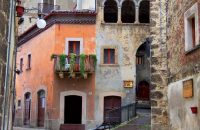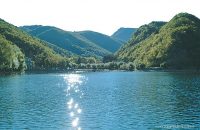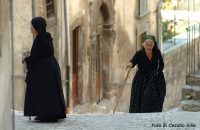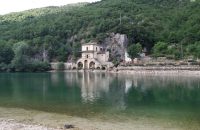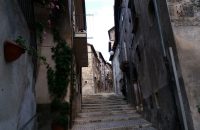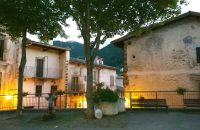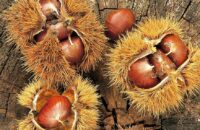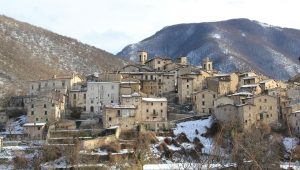 The town lies in the Sagittario valley, between Montagna Grande and Mount Godi within the Abruzzo National Park. There are no certain sources on the origin of the name, which could derive from scamnum (stool in Latin) because of the shape of the hill on which it stands, or from scandal and scannella, varieties of barley grown on the spot
The town lies in the Sagittario valley, between Montagna Grande and Mount Godi within the Abruzzo National Park. There are no certain sources on the origin of the name, which could derive from scamnum (stool in Latin) because of the shape of the hill on which it stands, or from scandal and scannella, varieties of barley grown on the spot
What makes Scanno special, however, is not only its natural setting but also its historic center, rich in medieval, Renaissance and Baroque architecture and distinguished by a lively and flourishing craftsmanship that ranges from precious lace to gold and silver filigree jewelry. For all these reasons the town is part of Italy’s Most Beautiful Villages.
The area has been inhabited since Roman times, and over the centuries historical events have shaped the conformation of the village, different styles belonging to different eras in fact overlapping. The urban layout is typical of Apennine villages, while from a folkloric point of view the influences are oriental. In the past, the Saracens and Ottomans managed to enter the town, which left an imprint on the clothing, particularly the women’s; the women’s traditional headgear evokes a turban, and the draperies are reminiscent of the Orient in prints and decorations.
Origins aside, the first document attesting to its existence dates back to 1067, and Scanno passed through the centuries from one feudal lord to another to experience its heyday between the seventeenth and eighteenth centuries, when what is perhaps the village’s finest boast was born, the women’s costume, still a source of luster for those who wear it. The spread of the costume is contemporary with the rise of the wool industry and the art of dyeing; the skill of Scanno’s women in weaving was known throughout the Kingdom of Naples.
Of the ancient city walls only one of the four gates, Porta della Croce, remains today. The numerous arches within the alleys, the stone portals, the two Baroque fountains, the aristocratic mansions, the churches and what was the street furniture of the time, testify to a desire to amaze that contrasts with the severe mountain environment. This is why Scanno has always attracted the great masters of photography, such as Henry Cartier-Bresson, Mario Giacomelli, Ferdinando Scianna, Giovanni Bucci and many others. The village is also home to the famous “Scanno Prize,” which was initially intended as a literary award and has now become an important multidisciplinary prize in the Italian cultural scene
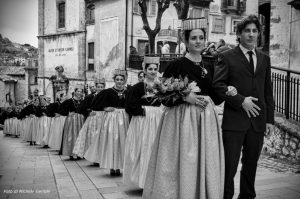 The old folklore and traditions of yesteryear are not only evoked, however, by the shop windows that abound with jewelry, embroidery, and lace-making. There are several popular events, such as Live the Costume, the week dedicated to Scanno’s ancient women’s costume. Seven days full of initiatives, exhibitions and cultural routes to learn about and appreciate the customs of the past through a dress that is memory and pride of this historic village. There is also the festival of the Glories of St. Martin that takes place in November, when huge stacks of wood and logs, up to twenty meters high, are raised on the heights surrounding the village. These pyres are lit at sunset and burn all night creating spectacular effects. The young people, in keeping with tradition, dye their faces black with soot, extolling their contrada and improvising singing and dancing. At the end of the feast, the palancone, or the central torch of the winning bonfire, is presented to the newlywed bride, who offers wine and sweets.
The old folklore and traditions of yesteryear are not only evoked, however, by the shop windows that abound with jewelry, embroidery, and lace-making. There are several popular events, such as Live the Costume, the week dedicated to Scanno’s ancient women’s costume. Seven days full of initiatives, exhibitions and cultural routes to learn about and appreciate the customs of the past through a dress that is memory and pride of this historic village. There is also the festival of the Glories of St. Martin that takes place in November, when huge stacks of wood and logs, up to twenty meters high, are raised on the heights surrounding the village. These pyres are lit at sunset and burn all night creating spectacular effects. The young people, in keeping with tradition, dye their faces black with soot, extolling their contrada and improvising singing and dancing. At the end of the feast, the palancone, or the central torch of the winning bonfire, is presented to the newlywed bride, who offers wine and sweets.
The territory of Scanno, between 950 and 2250 m above sea level, is largely included in the Abruzzo National Park, Italy’s second oldest nature reserve, within which bear, chamois, deer and wolves live. The magic of nature becomes more vivid in the valley, where the village is washed by the lake of the same name, a mirror of clear water that is also the largest natural lake in Abruzzo. Surrounded by dense vegetation of oaks, poplars, willows and linden trees that in autumn provide an exceptional color palette. It is not impossible around Lake Scanno to come across a deer or fox drinking in its waters, which even in winter never completely freeze over.
Read more:
www.borghipiubelliditalia.it
How to get to Scanno (AQ): the route



